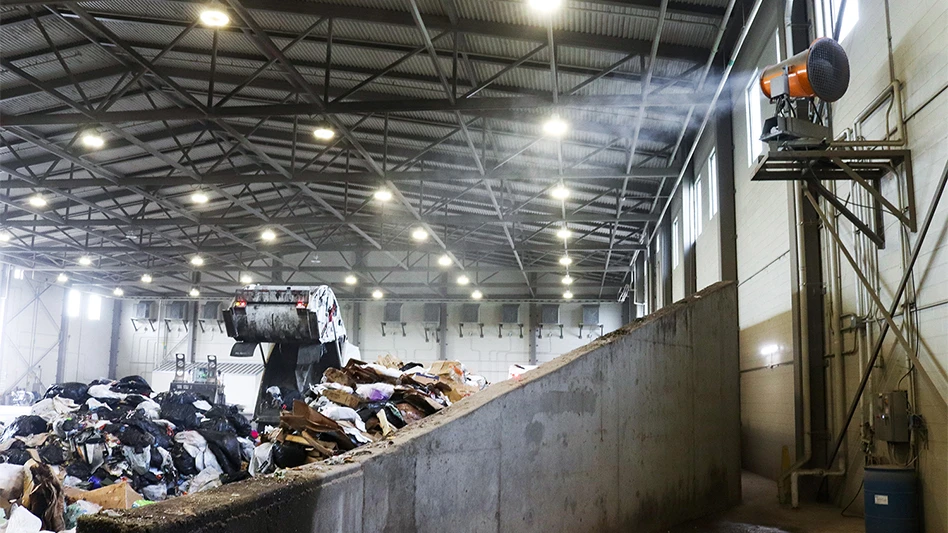
Photo courtesy of BossTek
Peoria, Illinois-based BossTek, the maker of DustBoss dust suppression equipment, says DB-30 Injektor mist cannons recently installed by the North Texas Municipal Water Department (NTMWD) are helping that organization create a safer work environment at the transfer stations and recycling depots it operates.
BossTek and its customer are crediting the mist cannons for having “significantly" reduced the amount of dust emissions during the offloading of construction and demolition (C&D) and municipal solid waste (MSW) materials for transfer and recycling, initially at just one of its locations.
Equipped with dosing attachments for odor control, BossTek says the outcome at the initial NTMWD facility has been its ability to stay compliant with air quality regulations and become “a more pleasant workplace.”
The results from the initial installation, the company says, include better relations with the surrounding property owners and the installation of mist cannons in the rest of the department’s facility portfolio.
“From now on, any new transfer station will have a DustBoss as part of the original design,” says Mike Friesen, assistant deputy of solid waste for the NTMWD. “Safety is our No. 1 priority, and this equipment provides a significant upgrade for us,” he adds. “The technology will be an integral part of our operations moving forward.”
NTMWD serves 930,000 people by providing solid waste disposal services to five cities (Allen, Frisco, McKinney, Plano and Richardson, Texas), as well as Collin County and the surrounding area in suburban Dallas and northeast Texas.
Solid waste is picked up from residents and businesses and delivered to one of three transfer stations (two in Plano and one in Richardson). The three locations process up to 3,370 tons per day of both MSW and C&D materials.
At the NTMWD facilities, loads are deposited onto the 33,000-square-foot tipping floor and sorted and repositioned by wheel loaders
One dust emission point occurs during the initial waste drop-off and the sorting and pushing of material can cause dust to become airborne when pushed by the wheel loaders. As outbound material is dropped into trailers, the turbulence from the impact and the vertical airflow through the tunnel below forces the particulates back up through the shaft and into the building.
The first two DustBoss DB-30 Injektor units were mounted at the NTMWD Lookout Transfer Station approximately 10 feet above the tipping floor. They were positioned to reach above the piles and cover much of the tipping floor area.
Water in the cannons is mixed with an odor neutralizer by a dosing pump before it reaches a misting ring with 30 nucleating nozzles. The nozzles fracture the pressurized water into millions of tiny droplets.
With a throw of 100 feet (30 meters), the unit’s 50-degree vertical adjustment and 70-degree oscillation range increase the coverage area to 6,100 square feet (566 square meters).
Operators use a touchscreen interface on the control box at the base of each elevated unit to set the volume of water, throw distance, vertical settings and oscillation range. The settings are designed to offer “exacting control for the constantly changing operational conditions and traffic volumes,” the equipment provider says.
“The dynamic of creating a mist of dosed atomized droplets made this a highly effective method of double-duty odor and dust control,” Friesen says. “When the machine is on, we can see the dust get pulled from the air and dragged to the ground before it reaches air intakes or exhaust vents.”
The wall-mounted cannons are fed by a standard 1-inch hose attached to a booster pump, fed by a city water source. Rather than relying on high pressure from the hydrant, the pressure delivered by a booster pump in the DB 30 requires less output from the city and reduces the amount of pooling and standing water in the area, says BossTek.
“Our experience with the machines and BossTek service has been excellent," Friesen says.
Latest from Recycling Today
- Lautenbach Recycling names business development manager
- Sebright Products partners with German waste management equipment company
- WasteExpo transitions to biennial format for enhanced experiences
- Study highlights progress, challenges in meeting PCR goals for packaging
- Washington legislature passes EPR bill
- PureCycle makes progress on use of PureFive resin in film trials
- New copper alloy achieves unprecedented high-temperature performance
- Gränges boosts profits and sales volume in Q1 2025





